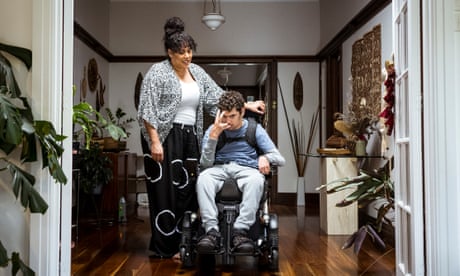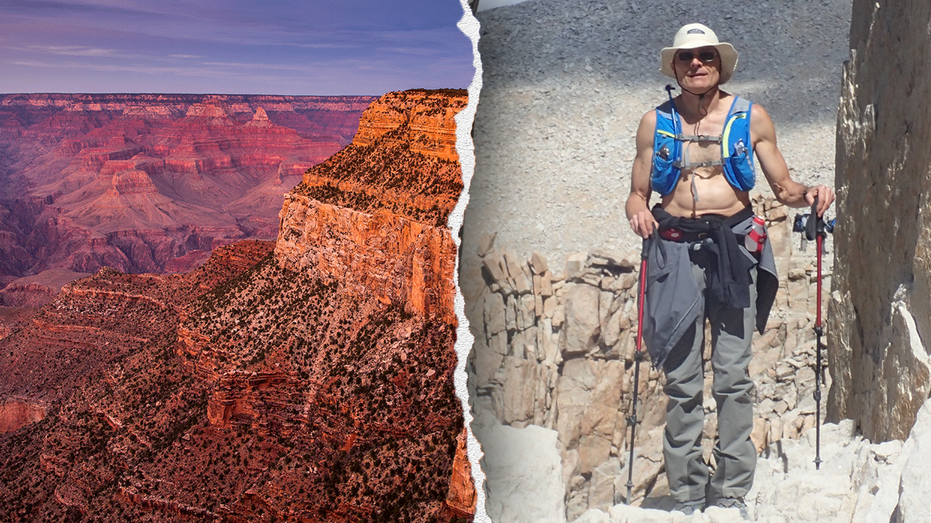- by foxnews
- 23 May 2025
One-size-fits-all model of accessible housing ‘a disaster’ for Australians with disability
One-size-fits-all model of accessible housing ‘a disaster’ for Australians with disability
- by theguardian
- 04 May 2022
- in news

Elijah Armstrong's wheelchair is 76cm wide. The doorways at the rental home he shares with his family are 78cm wide.
"Every time he goes through a door I think: 'is he alright getting through the door? Can he make it?'" his mother, Grace Dlabik, says.
"You're never able to live comfortably knowing that everything is OK in the home. You're always mindful, and you're hyperaware every time he's using the space that he might potentially crash into something."
Elijah has cerebral palsy. He's quadriplegic, and uses an electric wheelchair. A house that was accessible for his needs would have doorways that were 90cm wide. It would have a hoist on the ceiling, so Dlabik and her partner, Morganne Blackburn, would not have to manoeuvre the portable hoist into his bedroom each morning. It would have a shower that could comfortably fit a shower chair, instead of one that only just squeezes in.
But accessible housing for families is in short supply, so Dlabik has made the best of what is available on the private rental market.
They moved into their current home, a large art deco house in the Melbourne suburb of Pascoe Vale, in September. Dlabik found it during a daily scour of realestate.com.au, after spending a year searching for an accessible property.
"Elijah is 19 now, and we've never had accessible housing," Dlabik says. "This particular property isn't accessible by the standards of accessible housing, it just is a lot more accessible than any other house that we've ever been able to find."
The house is beautiful, with large living areas and original mouldings. The formal entryway is wide enough for the 5m turning circle of Armstrong's wheelchair.
"For us, it's not a luxury to be living in a double-fronted renovated home, it just is a necessity," she says.
Their story is a common one. The national disability insurance scheme (NDIS) funds specialist disability accommodation, but the waiting list is long and the packages lean toward shared accommodation models, with several adults sharing a home with the assistance of live-in support workers. Elijah has received funding to live in shared accommodation but it would mean moving out of home, something he does not want to do.
NDIS also funds home modification projects, but it is a significant hurdle to get a landlord to agree. The national construction code was modified last year to require all new builds to have basic accessibility features, but those changes do not meet all Elijah's needs.
"There needs to be a much more holistic approach where people with disabilities have choice and control in who cares for them," says Dlabik. "Supporting families to stay together should be a priority especially because Elijah doesn't want to live out of home.
"There should be an option for us to stay together as a family and not be forced to relinquish care just because we don't have the funds to build an accessible house."
Dr Di Winkler, the chief executive of the Summer Foundation, which advocates for housing options for people with disabilities, says that appropriate housing "not only leads to better outcomes for the person, it actually reduces the need for costly supports".
"The one-size-fits-all model of housing for people with disability has proven to be a disaster on so many levels over many decades," Winkler says. "Housing that truly meets the needs of an individual is essential both for the quality of lives of people with disability and for the sustainability of the NDIS."
It took 12 months of searching for Dlabik to find the home they now live in. She began a citywide search for an accessible property, which involved a public call out on social media, support from high-profile Melbourne advocates like Carly Findlay, and an appearance on ABC Radio. It did not turn up any wheelchair-accessible homes.
Dlabik also wrote to realestate.com.au and domain.com.au to request they introduce a search filter for accessible housing. The REA Group told Guardian Australia that adding that search option was "currently under consideration on realestate.com.au and is actively being rolled out across another REA Group platform as part of our ongoing improvements".
In the end, she found the house by scouring real estate websites, looking through every photo of every listing to gauge whether they might be suitable.
The house was at the outer edge of their search area - Elijah's allied health professionals and Dlabik's business are all located in the inner north.
But after periods of homelessness - followed by a stay in a rental house where they had to bring in a bath from the garden to bathe Elijah in the kitchen, carrying him up and down steps - it was too good to pass up.
The halls are wide enough that Elijah can move around the house by himself and it has an accessible tram stop right out the front.
The rent is $3,300 a month, a figure that eats up most of Dlabik's income.
"And it's not because we want to live in a luxurious house like this, but because it's a necessity for us and if we don't have this we have nothing. I'll have to start from scratch again and scour through every single listing again for another year."
A 2018 study, based on data from the Household, Income and Labour Dynamics in Australia survey, found that 11.2% of Australians with disability were living in unaffordable housing. Unaffordable housing was defined as a person on a low income who spends 30% or more of their income on housing costs.
Others who spoke to Guardian Australia were spending considerably more than that. Hazel*, a 24-year-old from Sydney, spends 63% of their fortnightly income to rent a one bedroom apartment in Dulwich Hill.
The rent is $350 a week. It was the cheapest apartment they were able to find in Sydney's inner west within a manageable distance to their therapist's office.
"A home is so important to me, especially having experienced homelessness and domestic violence. I just need somewhere safe that I can be, and this is that," they say.
Hazel is autistic, has PTSD and shares their home with a trainee assistance dog. Their housing needs are not complex, but they cannot live in a sharehouse. They receive the disability support pension, plus an additional $130 a fortnight in rent assistance. After paying rent, they have just over $300 a fortnight to cover bills and groceries. Their NDIS package covers support workers but no accommodation costs.
"So many people have had their NDIS packages cut recently that I don't want to have a review to ask for accommodation support, in case I lose what I already have," they say.
*Some names have been changed.
- by foxnews
- descember 09, 2016
United Airlines flight returns to Hawaii after concerning message found on bathroom mirror; FBI investigating
United Airlines Flight 1169 to Los Angeles returned to Hawaii after a "potential security concern" aboard the plane. The FBI and police are investigating.
read more


